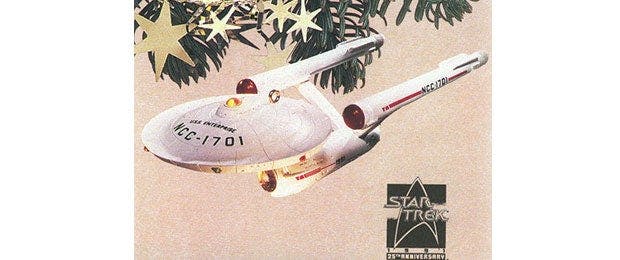
When Hallmark Cards included the Starship Enterprise among its Keepsake Ornaments line in 1991 to celebrate the 25th anniversary of Star Trek, no one anticipated there might be a second Star Trek ornament to hang along with it—let alone more than 50 of them.
But 20 years later, Star Trek fans continue to add to their trees—and to their collections—ships, scenes and characters from every incarnation of the series and films as interpreted by Hallmark Keepsake Ornament sculptors and artists. To celebrate this milestone year for Trek ornaments, here’s a two-part look at highlights and insights on two decades of Star Trek and Hallmark. Read about the first decade below, and be on the lookout for the rest in part two tomorrow.
1991—Starship Enterprise was the first iconic non-character to be licensed and produced as a Keepsake Ornament. The ornament’s unexpected popularity also prompted it to be the first Keepsake Ornament to go back into production after selling out in stores well before Christmas. Keepsake Artist Lynn Norton, who sculpted the ornament, says initial concept drawings depicted Santa Claus popping out of a hinged bridge dome and garland draped around the primary hull. A Star Trek fan since the first night of The Original Series broadcast, Norton fought to change the design to be more accurate. He went on to sculpt all but one of the succeeding Star Trek ship ornaments.
1992—Shuttlecraft Galileo, sculpted by Dill Rhodus, was the first Star Trek ornament to feature an original voice recording. Leonard Nimoy recorded a holiday message as Spock for the ornament, which was featured in the first national television advertisement for a single Keepsake Ornament.
1993—U.S.S. Enterprise marked Hallmark’s first ornament based on Star Trek: The Next Generation. The NCC-1701-D was the first starship ornament to have lighted nacelles. For whatever reason, photos of this ornament in advertisements and publications tended to be run upside-down. A television commercial for this ornament featured Patti Yasutake as Nurse Alyssa Ogawa asking questions to the Enterprise-D’s computer about the ornament.
1994—The Klingon Bird of Prey is one Keepsake Ornament that almost didn’t happen. Not only were there initial concerns about producing an ornament featuring such clearly defined wingtip weapons, its design failed initial safety testing as the patented circuitry that Hallmark invented to plug ornaments into light strings produced too much heat inside the small hull of the ship. At the last minute, a talented engineer at Hallmark redesigned the circuitry to comply with UL and still keep the original patent. The newly designed circuit was so efficient that it was later used in all Hallmark lighted ornaments that plugged into light strings.
1995—Not only was this the first year to feature more than one Star Trek ornament, it was the first to see characters as ornaments with the introductions of Captain James T. Kirk and Captain Jean-Luc Picard. To differentiate the ornaments, Keepsake artists added “props” to each figure (Kirk’s captain’s chair and corridor panels for Picard). Other ornaments included the Romulan Warbird (TNG-era) and a set of three miniature ornaments, The Ships of Star Trek, based on designs in 1991, 1993 and 1994. Full-size combadge pins were manufactured by Hallmark and offered as a free gift to those who purchased all of the Star Trek ornaments that year.
1996—To celebrate the 30th anniversary of Star Trek, Keepsake Ornaments produced a set based on designs of the 1991 and 1992 ornaments but made from die-cast zinc and electroplated with nickel. A display base for the set featured a recording of William Shatner’s opening narration, making this the first ornament to use a recording from the show itself. The year’s U.S.S. Voyager ornament was the first based on that series. Figure ornaments included Mr. Spock and Commander William T. Riker. Hallmark manufactured an embossed pin with the official 30th anniversary Star Trek logo that was offered as a free gift to those buying all of the year’s ornaments.
1997—Three ornaments were offered this year, including the first from Star Trek: Deep Space Nine, the U.S.S. Defiant. Figures were Commander Data and Dr. McCoy, who artists placed on a transporter pad as an in-joke to fans who might know of the physician’s fears of having his atoms scattered across space by the gadget.
1998—With Star Trek: First Contact being released that year, Hallmark worked in advance of the film to produce an ornament based on the U.S.S. Enterprise NCC-1701-E. Designs were based on early art that showed the starship’s deflector dish glowing blue, a color that was changed to amber for the final film. The ornament was changed to glow amber just prior to production. Joining the Enterprise-E that year as an ornament was Captain Kathryn Janeway.
1999—Three of the four Star Trek Keepsake Ornaments this year each represented firsts for the line. Worf was the first figure not to include a prop. U.S.S. Enterprise NCC-1701 was the first to feature a porcelain replica of postage-stamp art. The U.S.S. Enterprise ornament was the first of the line to be made of blown glass. Rounding out the year’s offerings was Runabout—U.S.S. Rio Grande from DS9.
2000—This year’s Borg Cube ornament features a recording of a Hallmark sound engineer’s voice synthesized to sound like a Borg communication. While Keepsake Artist Lynn Norton recorded the ornament’s message himself, the engineer’s test recording ended up being the preferred sound sample. Other ornaments for the year were a blown-glass Lt. Commander Worf and a figure of Seven of Nine.

